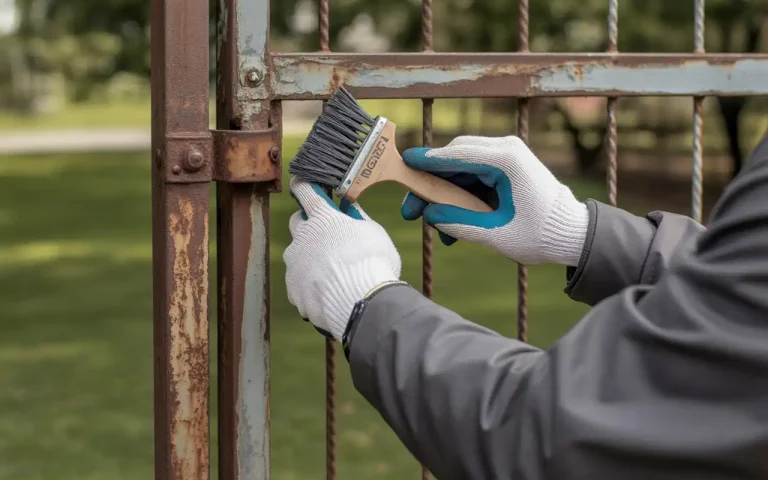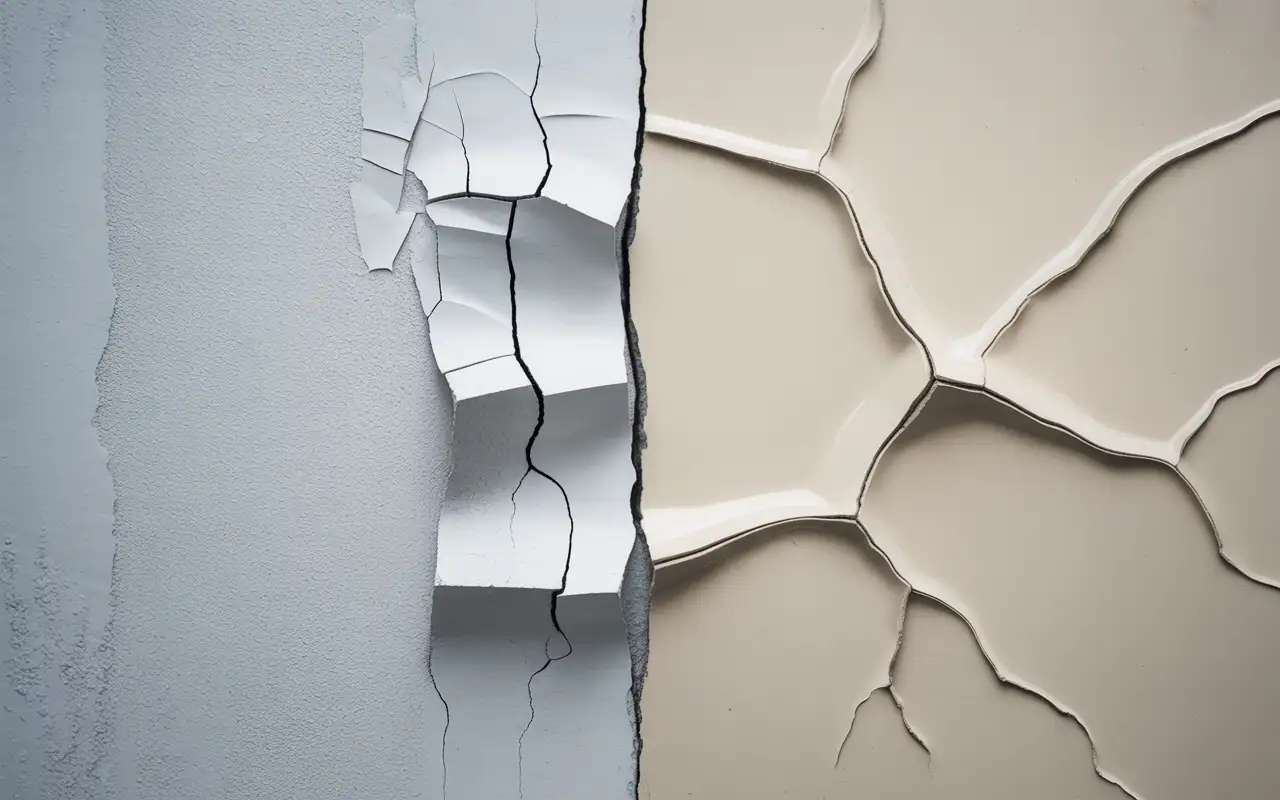How to Remove Paint from Metal: 6 Pro Methods (2025)
Removing old or failing paint is necessary before any quality restoration project. The best way to remove paint from metal depends on the item’s size, shape, and the type of metal, but using the correct method prevents damage and ensures a lasting finish. We will guide you through the safest and most effective paint removal techniques for metal, from simple household fixes to professional-grade chemical stripping.
This guide provides the trade secrets and processes used by master painters, focusing on real-world experience and safety. Our goal is to give you trusted, comprehensive instructions, whether you are dealing with a small tool or a large outdoor metal surface.
Table of Contents
ToggleStep by Step Instructions for How to Remove Paint from Metal

Method 1: Chemical Paint Strippers (Best for Most Projects)
Chemical paint strippers work fast on stubborn paint layers. They break down paint bonds in 30 minutes to 2 hours.
What You’ll Need:
- Paint stripper for metal ($15-35 per quart)
- Chip brush ($3-5)
- Putty knife or scraper ($8-12)
- Chemical-resistant gloves ($10-15)
- Safety goggles ($8-12)
Cost: $45-80 total Time: 1-3 hours for most projects
Step-by-Step Process:
- Set up outdoors or in a well-ventilated area. Open all windows and doors.
- Protect the ground with plastic sheeting or cardboard.
- Apply a thick layer of paint stripper using your chip brush. Don’t skimp here. Use enough to fully coat the metal surface.
- Wait 30-45 minutes. You’ll see the paint bubble and wrinkle. Some tough paints need 2 hours.
- Test a small spot with your putty knife. If paint lifts easily, you’re ready. If not, wait another 15 minutes.
- Scrape off loosened paint at a 45-degree angle. Work in small sections to avoid spreading mess.
- Wipe the surface clean with mineral spirits on a rag.
- Repeat on stubborn spots. Some oil-based paints need two applications.
Pro Tip from Experience: I once spent 6 hours on a client’s wrought iron fence using the wrong stripper. Citrus-based removers work great indoors but take twice as long outdoors. Save time with methylene chloride strippers for outdoor metal pieces.
Best For: Outdoor furniture, railings, gates, large flat surfaces
Method 2: Heat Gun Technique (Fast but Requires Skill)
Heat guns soften paint quickly. They’re my go-to for detailed work and curved surfaces.
What You’ll Need:
- Heat gun ($30-80)
- Paint scraper ($8-12)
- Heat-resistant gloves ($12-18)
- Safety goggles ($8-12)
Cost: $60-125 total Time: 2-4 hours for medium projects
Step-by-Step Process:
- Plug in your heat gun and set it to medium heat (around 500°F).
- Hold the gun 3-4 inches from the metal surface.
- Move it slowly back and forth. Don’t stay in one spot.
- Watch for paint to bubble and lift. This takes 15-30 seconds per section.
- Immediately scrape the softened paint with your putty knife.
- Work in 6-inch sections. Keep the gun moving to prevent metal warping.
Common Mistake I See: People crank heat guns to maximum. This warps thin metal and creates toxic fumes. Medium heat works better and safer.
Last month, a DIYer brought me an aluminum door he’d warped with high heat. The replacement cost $340. Keep your heat gun on medium for aluminum and thin steel.
Best For: Doors, window frames, decorative metalwork, spot removal
Method 3: Angle Grinder with Strip Disk (Fastest for Large Areas)
Angle grinders remove paint in minutes. They’re loud and messy but incredibly effective on sturdy metal.
What You’ll Need:
- Angle grinder ($50-120)
- Strip disk or flap disc ($8-15 each)
- Safety goggles ($8-12)
- Dust mask or respirator ($15-30)
- Hearing protection ($10-20)
Cost: $90-200 total Time: 30 minutes to 2 hours
Step-by-Step Process:
- Attach a medium-grit flap disc (80-120 grit) to your grinder.
- Put on all safety gear. This method throws debris everywhere.
- Hold the grinder at a 15-20 degree angle to the metal surface.
- Move steadily across painted areas. Don’t press hard or stay in one spot.
- Let the tool do the work. Too much pressure damages the metal.
- Switch to wire wheels for stubborn spots and crevices.
Real Project Example: I stripped a 6-foot steel gate last week. Chemical stripper would’ve taken 3 hours. The angle grinder finished in 45 minutes. But I wouldn’t use this on anything decorative or thin.
Best For: Steel beams, thick metal furniture, industrial equipment, painted fences
Not Recommended For: Aluminum, stainless steel, thin metal, detailed surfaces
Method 4: Baking Soda and Boiling Water (Best Budget Option)
This natural method costs under $5 and works great on small metal pieces.
What You’ll Need:
- Old pot you don’t cook with
- Baking soda (¼ cup per quart of water)
- Water
- Tongs
- Wire brush
Cost: $3-8 total Time: 30-45 minutes
Step-by-Step Process:
- Fill your pot with enough water to cover the metal items.
- Add ¼ cup baking soda per quart of water.
- Bring water to a gentle boil.
- Drop in your metal pieces carefully.
- Simmer for 15-20 minutes. The paint will start bubbling.
- Remove items with tongs. Let them cool for 2 minutes.
- Scrape off paint with a putty knife or wire brush.
What Works: Door hinges, cabinet hardware, tools, small decorative items
What Doesn’t: Anything larger than your pot, items with wood or plastic parts
I keep a dedicated pot in my work van for hardware removal. It’s saved me hundreds of replacement hinges and knobs over the years.
Method 5: Vinegar Soak (Gentlest Natural Option)
White vinegar removes paint slowly but safely. Perfect for delicate metals.
What You’ll Need:
- White vinegar (1-2 gallons, $5-10)
- Plastic container
- Scrub brush or old toothbrush
Cost: $5-15 total Time: 4-12 hours (mostly waiting)
Step-by-Step Process:
- Pour undiluted white vinegar into a plastic container.
- Submerge your metal items completely.
- Let soak for 6-8 hours. Check progress every 2 hours.
- Remove items and scrub with a brush.
- Rinse thoroughly with water.
- Dry immediately to prevent rust.
Best For: Antique hardware, aluminum pieces, brass fixtures, items with unknown paint age
Method 6: Orbital Sander (Best for Flat Surfaces)
Sanders removes paint through abrasion. They work well on large flat metal pieces.
What You’ll Need:
- Orbital sander ($40-100)
- Sandpaper (80-120 grit, $10-15)
- Dust mask ($15-30)
- Safety goggles ($8-12)
Cost: $75-160 total Time: 1-3 hours
Step-by-Step Process:
- Start with 80-grit paper.
- Move in overlapping circles.
- Don’t apply pressure.
- Switch to 120-grit for smoothing.
- Wipe clean with mineral spirits.
Best For: Metal doors, sheet metal, tabletops, filing cabinets
Essential Safety Precautions for Paint Removal

Ignoring safety measures can lead to serious harm. This is not just a warning; it is a professional requirement.
- Personal Protective Equipment (PPE): Always wear chemical-resistant gloves, safety goggles with side shields, and long sleeves. When using wire brushes, angle grinder, or chemical strippers, wear a respirator. A simple dust mask is not enough for chemical fumes or lead paint dust.
- Ventilation and Lead: Always work outdoors or in a space with superior ventilation. If the paint is old (pre-1978), assume it contains lead. Do not use sanding vs chemical paint removal methods that create dust. Use wet sanding or chemical methods, and dispose of the residue as hazardous waste, following local San Diego environmental laws.
- Disposal: Paint of metal residue, chemical-soaked rags, and stripper must be collected in sealed containers. Never put these materials in regular trash. Check with your local hazardous waste facility for proper disposal protocol.
After Paint Removal: Protecting Your Bare Metal
Bare metal rusts fast. Protect it within 24 hours of stripping.
Immediate Cleaning Steps
- Wipe the surface with mineral spirits to remove residue
- Use a degreaser if the metal feels oily
- Rinse with clean water
- Dry completely with clean rags
- For intricate pieces, use compressed air in crevices
Rust Prevention Methods
Option 1: Metal Primer (If repainting)
- Apply within 24 hours
- Use rust-inhibiting primer
- Cost: $15-25 per quart
- Covers 100-150 square feet
Option 2: Clear Sealer (If leaving bare)
- Spray or brush on clear coat
- Reapply yearly
- Cost: $12-20 per can
- Protects against oxidation
Option 3: Wax Coating (For indoor items)
- Paste wax creates moisture barrier
- Buff for shine
- Cost: $8-15
- Lasts 6-12 months
I always tell clients: primer costs $20. Rust replacement costs hundreds. Don’t skip this step.
Common Mistakes to Avoid (Lessons from 12 Years)
Mistake #1: Using the Wrong Stripper for Your Metal
Aluminum needs gentle chemical paint strippers. Steel handles aggressive ones. Using steel-grade strippers on aluminum caused $450 in damage on a client’s patio set.
Mistake #2: Not Testing First
Always test your method on a hidden spot. I learned this after etching visible damage on a customer’s stainless steel railing.
Mistake #3: Rushing the Process
Paint strippers need time to work. Scraping too early means more coats and wasted money. Wait the full recommended time.
Mistake #4: Skipping Neutralization
Chemical strippers need neutralization. Mineral spirits or water (check product label) removes residue that prevents new paint from sticking.
Mistake #5: Working in Wrong Weather
Don’t strip paint when it’s below 50°F or above 90°F. Cold slows chemical action. Heat causes rapid drying and poor results.
Mistake #6: Mixing Methods Wrong
Never use a heat gun after a chemical stripper. The chemicals become more dangerous when heated. Wait until the surface is completely clean.
When to Call a Professional
Some projects need professional help:
- Lead paint on large surfaces
- Commercial or industrial equipment
- Powder-coated finishes (extremely tough)
- Large-scale projects (over 100 square feet)
- Valuable antiques or custom metalwork
- Structural metal that can’t be damaged
Professional paint removal costs $2-8 per square foot. That’s $200-800 for a typical metal door or furniture piece.
Is it worth it? Compare DIY costs plus your time. If you value your weekend at $25/hour and the project takes 8 hours, you’ve spent $200 in time plus $80 in materials. Professional service might cost the same or less.
Contact SD Custom Painting
At San Diego Custom Painting, we’ve stripped paint from metal on hundreds of projects across San Diego County. Our team handles everything from delicate aluminum fixtures to heavy steel structures.
We specialize in both interior painting and exterior painting services in San Diego. Whether you need a single piece restored or an entire building’s metalwork refinished, we bring professional-grade equipment and 27 years of experience to every job.
Don’t waste your weekend fighting with stubborn paint. Get a free quote and let our experts handle the messy work while you enjoy your time. Call us today or request your free estimate online. We’ll assess your project, recommend the best approach, and deliver results that last.
Removing Paint from Metal: Our Conclusion
Learning how to remove paint from metal saves money and restores metal pieces to like-new condition. The six methods covered here work for different project types and budgets.
For most homeowners, chemical paint strippers offer the best balance of cost, speed, and results. They handle detailed work better than grinding and work faster than natural methods.
Remember these key points:
- Always test on hidden areas first
- Use proper safety gear every time
- Choose your method based on metal type
- Protect bare metal within 24 hours
- Consider professional help for large or lead-paint projects
Start with the simplest method for your project. You can always move to aggressive techniques if needed.
FAQs About Removing Paint from Metal
What is the best way to remove paint from metal quickly?
The fastest method is using a powerful, commercial-grade chemical paint stripper (gel or liquid) combined with a heat gun to speed up the reaction. Always prioritize speed after mastering all safety measures.
Will soaking metal pieces in vinegar ruin them?
No. A brief soak is generally safe for metal pieces like steel and iron. However, avoid soaking aluminum or brass for more than a few hours, as the acid in the vinegar can eventually cause discoloration or mild corrosion.
Is it better to use sanding vs chemical paint removal?
It depends on the surface. Sanding is faster for flat, durable surfaces but risks damaging the metal if too aggressive. Chemical removal is better for curved, detailed areas where you want to avoid scratches.
What is the best paint remover for metal furniture?
For delicate outdoor furniture, a citrus-based paint remover is often the safest choice. It works slowly but won’t warp or pit the metal detail. For larger, simpler sections, a light touch with an orbital sander is effective.
Do I need a special paint remover for steel?
Yes. Paint remover on steel can be a general-purpose solvent or caustic stripper, as steel is very durable. The most important step for steel is to apply an immediate primer to prevent rust once the paint from metal is gone.

Mark Sullivan
Mark Sullivan is a seasoned expert in the residential and commercial painting industry, with over 27 years of experience transforming homes across San Diego. His deep understanding of color, finishes, and surface preparation allows him to deliver exceptional results on every project. Mark is passionate about sharing practical painting advice, maintenance tips, and design insights that help homeowners make confident decisions. His expertise and dedication to quality are reflected in every article he contributes to the San Diego Custom Painting blog.
Related Article
- All Posts
- Cabinet Painting
- Home Painting



